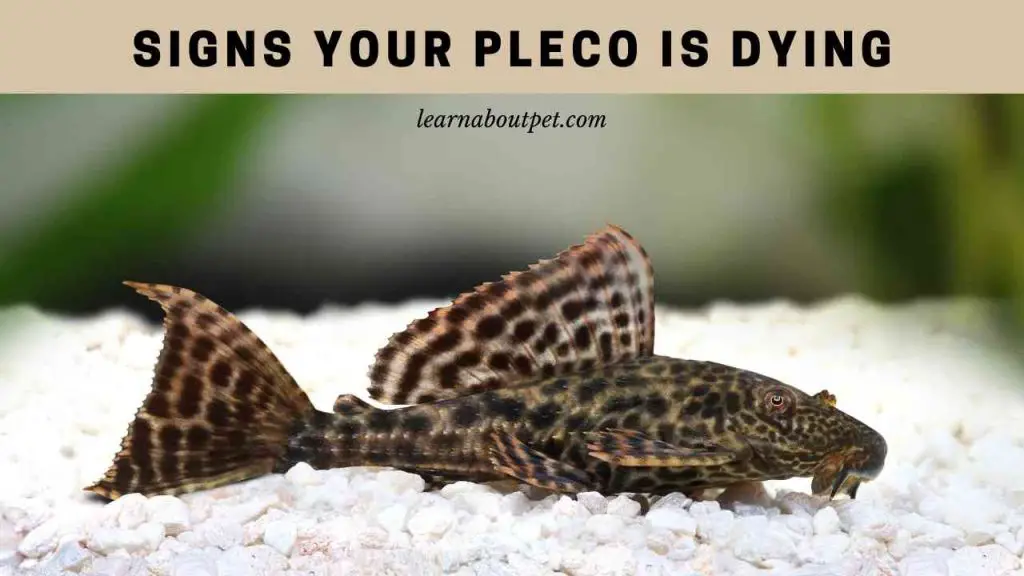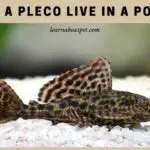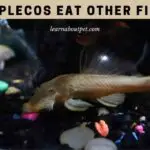No matter where anyone lives, pleco fish can make fantastic pets. Although it is generally very easy to maintain and requires little care compared to other pets, a pleco fish can get sick and die if not cared for properly. Fortunately, by monitoring it closely and knowing what to watch out for, you can easily tell when yours is sick or about to die.
Pleco fish show symptoms if something is wrong with them. Signs your pleco is dying include plecos losing its color, fins of pleco rotting and appearance of white spots on the body of pleco are some common symptoms that indicate the death of pleco.

Why Are My Plecos Dying?
Despite being such popular pets, Pleco fish are very vulnerable to death. The following is the list of behavioral causes and symptoms of dying plecos
- If a pleco fish stays on the surface of the water for most of the time or if the fish keeps its. Mouths open for most of the time are the sign that the fish is having trouble with breathing. The owners should look if their air filters are working properly. Lack of air in the aquarium can cause stress and anxiety among the plecos.
- Fishes tend to swim straight deep inside or in the middle of the aquarium if the owners notice that the dishes are swimming differently, like an upside-down, or sideways are troubling signs.
- Fishes like to interact with their environment. If the fish is just sitting at one place and/or isn’t interested in exploring the environment, it is also a problem and should be treated likewise.
- If the fins and scales of the fishes are unusual like any red veins or torn fins, it is a sign of stress. This can also happen if another fish is harming the fish.
- The owners should notice any new spots, bumps, or textures on the skin and face of the fish. These may be symptoms of a parasite infestation, bacterial infections or other serious conditions like fine white fuzz, especially around the mouth, or discoloration of the scales. This may indicate that he has a bacterial infection that requires treatment. In case you see a protrusion or swelling that was not there before, it could be a sign that he is sick. However, it could also mean that the fish is pregnant or that you have simply overfed it.
- The owners should pay attention to the eyes of pleco. An abnormal swelling, mucus buildup, or eyes that appear cloudy may be signs that the fish have a problem. Protruding eyes can be a sign of “bulging eyes,” which is usually due to an infection. If its eyes are dull or covered with an opaque film, it may be a sign that it is suffering from a vitamin deficiency.
- The owner should observe the eating patterns of the fish. The owner should watch it to make sure it will swim to try and find its food.
Signs Your Pleco Is Dying
Pleco fishes can show many different signs and the signs vary according to the problem that the flexo is facing. It is advised to go through the table below and look if there are any similar symptoms that the pet is going through and apply the treatment recommended. Some of the signs your Pleco is dying includes:
| Signs of dying pleco | Causes of the condition | Preferred treatment |
| If the pleco is having cloudy eyes |
|
|
| If the pleco is having popeyes |
|
|
| Body of pleco turning white |
|
|
| Rotting fins of pleco |
|
|
| Lack of enthusiasm and energy |
|
|
| The appearance of spots on the body |
|
|
| Abdominal swelling |
|
|
What Would Cause A Pleco To Die?
Understanding the signs your Pleco is dying are important but more important is understanding the causes of a dying or a dead Pleco. Following is the list of some causes that can lead to the death of Pleco fish.
Genetics
There can be many elements that can cause stress, infection or diseases, irritation, and anxiety among the plecos. However, Pleco itself is a problem. A Pleco fish may carry genetically defective complications which leads to its death.
Too Much Salt
If the owner has used too much aquarium salt in the aquarium, the Pleco fishes particularly don’t like to swim in water that has salt despite its benefits in the water, it is advised to avoid using it when petting Pleco fishes.
Food
Food plays an integral part in the life span of all animals. It is important to feed proper food to plecos. If the owner has set algae in the aquarium, that doesn’t mean the fish won’t need them to feed the food to plecos. Plecos require their owners to feed them two to three times a week depending on the fish.
Likewise overfeeding is also a reason for death. Overfeeding will increase the waste produced in the tank, making it dirtier. Constipation, swollen stomach, swim bladder diseases are all causes of overfeeding which eventually lead to death.

Bad Environment
If the aquarium water is contaminated, it can also cause death. Plecos cannot bear too much ammonia or nitrites. Ammonia and nitrites affect the health of plecos by burning their skin and fins. To avoid this to happen the tank should be cleaned regularly so that the tank is free from any uneaten food that causes ammonia and nitrates.
Another reason is poor conditions and lack of space in the tank. Plecos require 50 gallons of water to survive so the owners should make sure they get a tank of similar size and provide a natural environment with plants and hiding spaces in the tank so that fishes can become comfortable. Chlorine in the water is another reason for death among the plecos.
Diseases
Plecos can also die of an illness. Ich, fin rot, bacterial infection, dropsy, are some of the diseases that lead to the death of Pleco fishes.
How Do You Tell If A Pleco Is Stressed?
A Pleco fish can be judged by various symptoms that indicate stress levels. Once the owner assimilates that something is wrong with the pet, they should be quick to take action as fishes get sick very quickly and can die anytime. Sometimes fishes die without even giving any symptoms so it is also important to provide the best environment possible to the fish.
When an owner observes that the Pleco fish is showing negative symptoms the first thing they should do is consult a vet. Taking advice from a vet can help a lot and even changing the water can also sometimes give a huge relief to the fish as sometimes the water may be contaminated.
Signs Of A Stressed Pleco
- Lessen activity
- Heavy breathing
- No movement
- Lethargy
- Discoloration
- No food intake
- Hiding a lot
- Swollen eyes
- Bacterial infection
How Do You Save A Dying Pleco?
- The first thing that the owner should do is check for the signs your pleco is dying. After confirming that the Pleco is dying, the owner is required to separate the unhealthy pleco from the others if the owner has more than one. The owners should keep an eye on them, and observe if it feels better in a few hours.
- If the pleco suffers from an infection or if it is infested with a parasite, the disease can be spread if you leave it in the same aquarium. Sometimes just changing the water in the aquarium can be enough for the fish to begin to recover.
- The quality of the water should also be tested if the owners have any doubts about water. The aquarium water can be tested with a freshwater test kit.
- Clean the aquarium. There may be rotten food or other harmful things in the gravel at the bottom of the aquarium. So it is required to clean the aquarium to make sure that it is completely cleaned.
- If the pleco fish still appears ill, the owner may need to start treating it by the vet.
Why Is My Pleco Turning White?
Pleco fish turning white is a sign your pleco is dying. If the owner notices that the Pleco fish is turning white they should take fast action. Firstly they should get their Pleco to the vet immediately, maybe a doctor can help to relieve the symptoms by providing treatment to fish.
Plecos turn white due to lack of food, stress, sickness, hole in the head, temperature, improper alkaline levels or small tank size are all the promoters of changing the color of Pleco.
Why Did My Pleco Died Overnight?
No fish dies just suddenly, many factors contribute to the slow death of the pet including poor handling, poor environment, improper food, high-stress levels. All or some of these factors may contribute to the deterioration of the pleco’s health which leads to death at last.
How To Tell If Your Pleco Is Happy?
Besides having exotic texture or strips, Pleco fishes can be judged if it is healthy or not by assessing their fins, overall behaviour. A healthy Pleco fish also has a good round belly which is down on the body.
Furthermore, if the owner of Pleco observes that the Pleco is growing gradually, it is also an indicator of healthy Pleco. When everything is going fine, to further enhance the social life of plecos, the owners should introduce a different sex Pleco fish for mating.
Why Did My Pleco Turned White And Died?
Pleco turning white is one of the signs your pleco is dying Temperature, stress, food, environment, water or bullying all can lead to discoloration of plecos and eventually death. To have a healthy Pleco fish, owners should keep assessing all these factors and keep maintaining a quality life for the Pleco for it to survive.
Final Verdict- Signs Your Pleco Is Dying
Pleco fishes are famous for their beautiful skin. Their dark skin with white spots makes them look very different and exotic. However many observe signs your pleco is dying. Some of the signs of unhealthy pleco include Pleco turning in white or grey color and an owner may ask why is my pleco turning grey? Stress, infections, and a toxic environment can lead to the death of Pleco.

Other signs your Pleco is dying include swollen eyes, lack of energy, not moving etc. The owners should observe all the factors that may have affected the environment of fish and work accordingly.
After understanding all the signs of an unhealthy pleco fish, owners may ask How do I know if my pleco is healthy? A healthy Pleco fish will have a good round belly and would have good growth throughout the period.
As a pet lover, make sure to learn about pet more and give your pet fish a good and comfortable life!

Welcome to Learn About Pet. My name is Rajkumar Ravichandran and I love all pets, travel, and amazing food. I write about my passion and personal experience caring for multiple pets in this blog! ❤️
Post Disclaimer
DISCLAIMER: THIS BLOG OR WEBSITE, "Learn About Pet", DOES NOT PROVIDE YOU WITH MEDICAL ADVICE AND IS NOT A SUBSTITUTE FOR MEDICAL ADVICE. ALWAYS GET IN TOUCH WITH YOUR PERSONAL VETERINARIAN AND USE INFORMATION HERE AS GENERAL ADVICE.
The information, including but not limited to, text, graphics, images and other material contained on this website are for informational purposes only. No material on this site is intended to be a substitute for professional veterinary advice, food recommendation, diagnosis, or treatment. Always seek the advice of your veterinarian or other qualified health care provider with any questions you may have regarding a medical condition or for pet food related questions.







